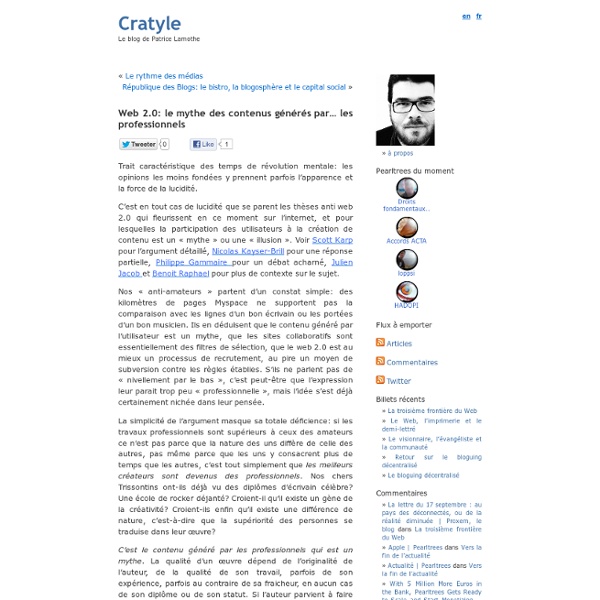Web 2.0: le mythe des contenus générés par… les professionnels

Cargo
Amzini | List of 900+ Top Social Networks & Social Networking Sites
Web 2.0 Directory | Web 2.0 Applications
Feedmyapp - Your Daily Web 2.0 Sites Dose
Web 2.0 Summit 2011 - Co-produced by UBM TechWeb & O'Reilly Conferences, October 17 - 19, 2011, San Francisco
The Web 2.0 Summit Points of Control Map
Productive Web Apps | WEB APPS TO HELP YOU AT WORK AND PLAY
What Is Web 2.0
by Tim O'Reilly 09/30/2005 Oct. 2009: Tim O'Reilly and John Battelle answer the question of "What's next for Web 2.0?" in Web Squared: Web 2.0 Five Years On. The bursting of the dot-com bubble in the fall of 2001 marked a turning point for the web. The concept of "Web 2.0" began with a conference brainstorming session between O'Reilly and MediaLive International. In the year and a half since, the term "Web 2.0" has clearly taken hold, with more than 9.5 million citations in Google. This article is an attempt to clarify just what we mean by Web 2.0. In our initial brainstorming, we formulated our sense of Web 2.0 by example: The list went on and on. 1. Like many important concepts, Web 2.0 doesn't have a hard boundary, but rather, a gravitational core. Figure 1 shows a "meme map" of Web 2.0 that was developed at a brainstorming session during FOO Camp, a conference at O'Reilly Media. Netscape vs. At bottom, Google requires a competency that Netscape never needed: database management.
Web 2 Map: The Data Layer – Visualizing the Big Players in the Internet Economy
As I wrote last month, I’m working with a team of folks to redesign the Web 2 Points of Control map along the lines of this year’s theme: “The Data Frame.” In the past few weeks I’ve been talking to scores of interesting people, including CEOs of data-driven start ups (TrialPay and Corda, for example), academics in the public dataspace, policy folks, and VCs. Along the way I’ve solidified my thinking about how best to visualize the “data layer” we’ll be adding to the map, and I wanted to bounce it off all of you. First, of course, some data. On the left hand side are eight major players in the Internet Economy, along with two categories of players who are critical, but who I’ve lumped together – payment players such as Visa, Amex, and Mastercard, and carriers or ISP players such as Comcast, AT&T, and Verizon. As you know, the map is a metaphor, showing key territories as “points of control.” But how? Now, a bit more detail on the data categories.
Related:
Related:




Un commentaire anonyme sur mon blog by Patrice Mar 1